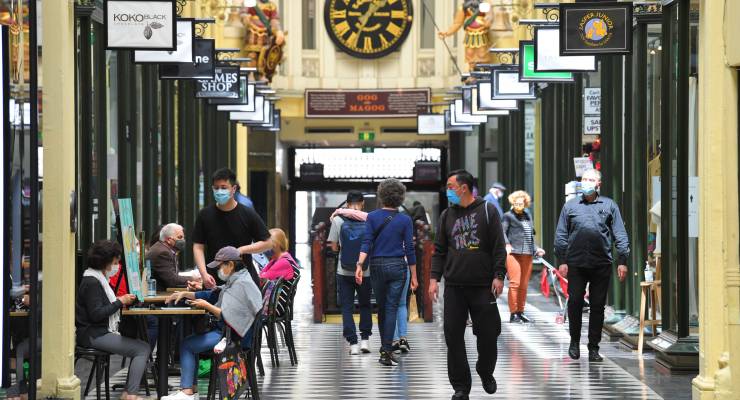
The Australian consumer was the hero of Australia’s third quarter GDP performance, managing to boost Australia’s recovery despite high unemployment, lockdown, and wages cuts — and further cuts in investment by Australian businesses.
The national accounts for the three months to September showed the economy moving strongly back into positive territory after two consecutive quarters of contraction, with 3.3% quarterly growth in the quarter.
The stronger-than-expected result was fueled by household spending, which rose 7.9% in the quarter after a fall of over 12% in the June quarter. That meant household final consumption expenditure added 4.0 points to the GDP result, a burst of spending in the three months to September that more than offset any negative impact from the second Victoria lockdown.
That strong result from ordinary consumers came despite wages growth (via the Wage Price Index result two weeks ago) hitting a record low in the quarter (total compensation of employees rose 2.3% on the back of jobs growth, a strong result that reversed the 2.3% fall in the June quarter).
It was in significant contrast to a 3% fall in business investment. That means the government’s forecast of a ~7% rise in business investment through the year will be harder to achieve.
Government spending also rose 1.4% — on top of already high levels of spending in the March and June quarters.
But households were the champions. Spending on services rose 9.8%, driven by spending on hotels, cafes and restaurants, health, as well as recreation and culture as lockdowns and containment measures eased.
The easing of restrictions also increased demand for goods, which rose 5.2% and is up 3.5% through the year. That through-the-year rise was one of the most important bits of data in the national accounts.
This goods spending helped keep the likes of Woolies, Coles, Aldi, and Metcash alive during the downturn — not to mention other consumer retail outlets like JB Hi-Fi, Harvey Norman, Adairs, Temple and Webster, and Kogan. That spending in turn kept employment levels buoyant for retailers and their suppliers.
Updates from all major retailers in the past month confirm that this high level of spending has continued into this quarter as well.
How long this burst of consumer spending can last is a key question for the Reserve Bank (RBA): can consumers continue to support the economy heading into 2021, or will their extra demand be exhausted as their savings run down and they try to keep their jobs and repay debt?
Consumers still have plenty of capacity for greater spending if they choose to: the national accounts showed the household saving ratio decreased to 18.9% from 22.1%
And that’s why we should take note of two parts of the opening address by RBA governor Philip Lowe to the House of Representatives Economic Committee yesterday. Explaining why the RBA was prioritising unemployment, he said:
In the current environment, the bigger stability risk is a protracted period of high unemployment, rather than excess borrowing. When people don’t have jobs, their spending is curtailed and they have difficulty servicing their debts. It is also worth noting that over the past 6 months, many households have improved their finances and paid down debt. It is possible that this attitude to debt will change again, but it is also possible that people will continue to take a more cautious approach to borrowing than they did before the pandemic. So this is something to keep an eye on. But for the time being, the priority is employment.
For now, it’s hard-pressed consumers who are doing the heavy lifting of an economy coming out of recession. Time for business to respond to their efforts with some investment to take advantage of it. Governments have offered enough carrots with investment write-offs, payroll tax cuts, and concessions and other assistance — its now up to business to show the same sort of courage their employees have been showing.









IT MUST BE TIME TO HELP BUSINESSES DO BETTER BY THROWING MORE MONEY AT THEM! OBVIOUSLY THE GOVERNMENT IS GIVING CONSUMERS TOO MUCH. BUSINESS CAN USEFULLY PUT MONEY IN THE POCKETS OF DIRECTORS AND SHAREHOLDERS, THEN IT WILL TRICKLE DOWN TO THE ORDINARY FOLK AND EVERYBODY WILL BE HAPPY. WHEN WILL THESE DICKHEADS WAKE UP?
I looked in vain through that list of expenditures for necessities or such as might make a better world.
Nary a one.
Neil Postman’s “Amusing Ourselves to Death” was too optimistic a Jeremiad.
“The Australian consumer was the hero, households were the champions, it’s hard-pressed consumers who are doing the heavy lifting”. Well done, Dyer & Keane.
You’ve broken all the economic journalism and conservative politics rules. Since the 1980’s, economists and economic journalists, let alone the LNP, have been extremely shy in acknowledging households or consumers are critical factors in economy wide activity, performance or GDP.
Quotes from ‘L’ Plate Treasurer Frydenberg’s address don’t indicate he lingered or expanded on the importance of consumer spending either.
It’s only a few years ago that Ross Gittins, buried in the business section of the SMH, broke ranks and wrote that consumer spending is the beating heart of the economy.
Well, we don’t want wage earners getting ideas about their self importance, do we? Gosh, they might start thinking wage rises are important to stimulate the consumer spending that we say the economy needs!
When the LNP continues its long history of opposing wages rises in any industrial tribunal or commission, someone could point out their hollow argument, since they have acknowledged wage rises boost consumer spending, which is critical to economic growth.
No wonder Frydenberg prefers to gloss over the importance of consumer spending in the total performance of the economy.